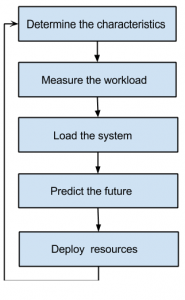This set of Cloud Computing Multiple Choice Questions & Answers (MCQs) focuses on “Capacity Planning”.
1. Which of the following correctly describes the following figure?

a) Capacity Planning
b) Performance Planning
c) Network Planning
d) None of the mentioned
View Answer
Explanation: Capacity planning measures the maximum amount of work that can be done using the current technology and then adds resources to do more work as needed.
2. Point out the correct statement.
a) Capacity planning seeks to match demand to available resources
b) Capacity planning examines what systems are in place, measures their performance, and determines patterns in usage that enables the planner to predict demand
c) Resources are provisioned and allocated to meet demand
d) All of the mentioned
View Answer
Explanation: Performance tuning and optimization is not a primary goal of capacity planners.
3. What is the relation of the capacity attribute to performance?
a) same
b) different
c) similar
d) none of the mentioned
View Answer
Explanation: With capacity, you are concerned about how much work a system can do, whereas with performance, you are concerned with the rate at which work gets done.
4. What does L in LAMP stands for?
a) Lamp
b) Linux
c) Lone
d) None of the mentioned
View Answer
Explanation: LAMP stacks based on Red Hat Linux are more common than the other distributions.
5. Point out the wrong statement.
a) Network capacity is one of the easiest factors to determine
b) A system uses resources to satisfy cloud computing demands that include processor, memory, storage, and network capacity
c) Scaling a system can be done by scaling up vertically to more powerful systems
d) All of the mentioned
View Answer
Explanation: Network performance is affected by the network I/O at the server, network traffic from the cloud to Internet service providers, and over the last mile from ISPs to homes and offices.
6. Which of the following is one of the major categories of Amazon Machine Instances that you can create on the Amazon Web Service?
a) WAMP
b) XAMPP
c) LAMP
d) None of the mentioned
View Answer
Explanation: On Amazon Web Services, machine instances are offered for both Red Hat Linux and for Ubuntu.
7. Which of the following is used as a substitute for PHP as a scripting language in LAMP?
a) Scala
b) Perl
c) Ruby
d) None of the mentioned
View Answer
Explanation: Either Perl or Python is often substituted for PHP as the scripting language used.
8. Which of the following RDBMS is used by LAMP?
a) SQL Server
b) DB2
c) MySQL
d) All of the mentioned
View Answer
Explanation: MySQL is the database server developed by the Swedish company MySQL AB, owned by Oracle Corporation through its acquisition of Sun Microsystems.
9. Which of the following is a critical step in capacity planning?
a) Predict the future based on historical trends and other factors
b) Load the system until it is overloaded
c) Deploy or tear down resources to meet your predictions
d) All of the mentioned
View Answer
Explanation: Knowing when systems fail under load and what factor(s) is responsible for the failure is the critical step in capacity planning.
10. Which of the following is the hardest factor to determine?
a) Network performance
b) Network capacity
c) Network delay
d) All of the mentioned
View Answer
Explanation: It is the goal of a capacity planner to identify the critical resource that has this resource ceiling and add more resources to move the bottleneck to higher levels of demand.
Sanfoundry Global Education & Learning Series – Cloud Computing.
Here’s the list of Best Books in Cloud Computing.
To practice all areas of Cloud Computing, Here is complete set of 1000+ Multiple Choice Questions and Answers.
If you find a mistake in question / option / answer, kindly take a screenshot and email to [email protected]
- Practice MCA MCQs
- Apply for Computer Science Internship
- Practice Computer Science MCQs
- Check Cloud Computing Books
- Check Computer Science Books
